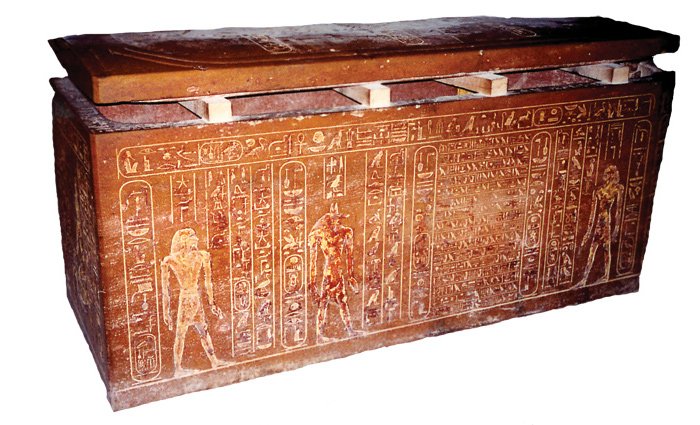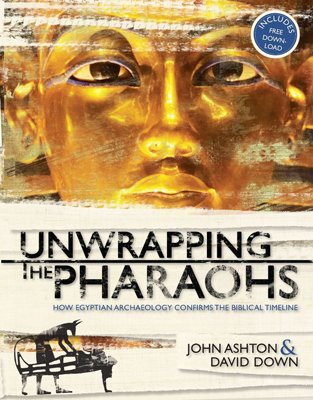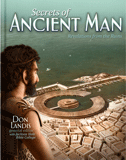
Chapter 1
Pyramids and Mummies
You may have read about them, seen pictures of them, or watched documentaries of them, but until you have stood in front of these massive mountains of stone you cannot grasp the immensity of it all.
The pyramids of Giza, an outer suburb of Cairo, are enormous. You may have read about them, seen pictures of them, or watched documentaries of them, but until you have stood in front of these massive mountains of stone you cannot grasp the immensity of it all.
The largest of these three great pyramids was built for King Khufu, whose Greek name was Cheops. It measures 751 feet (229 m) from one corner to another and was originally 479 feet (146 m) in height. It has been estimated that there are about 2,300,000 blocks of stone in his pyramid and these stones weigh up to 30 tons each. More recent calculations suggest it would be more likely that 3 million stones were used in the construction. If this mass of stone was cut into cubes about a foot square (30 cm x 30 cm x 30 cm) in size and placed side by side around the coast of Australia, only half the stones would be used. There would be enough left over to circle the borders of the United States of America.

The kings of Dynasties 1 and 2 were buried beneath mastabas, mud brick structures beneath which were tomb chambers.
It is not just the volume of stone that impresses; it is the skill and engineering ability that enabled the ancient Egyptians to cut these huge blocks of stone from the quarries and erect them on the plateau in such symmetrical form. Archaeologists are still not sure how this great engineering feat was accomplished in the lifetime of one man. Why did the early Egyptians build these massive monuments of stone? To answer that question we need to understand something of the history of Egypt and the Egyptians’ concept of life after death.

One Egyptian concept of stellar movements was that a divine scarab beetle pushed the sun in its assumed orbit around the earth.
The ancient Egyptians were a very religious people. They worshiped many gods and believed in an afterlife. They spent a lot of time and money in preparing for this future life. Most modern religions believe in the existence of a soul or spirit that leaves the body after death. The Egyptians believed there were two entities that left the body at death. The ka was supposed to dwell in the tomb of the deceased and could occupy the mummified body. The ka partook of the food offerings that were provided by those who cared for the tomb. The ba could leave the tomb to travel the Nile or enjoy the outdoor life and then return to the tomb at night. For the ba to continue its peaceful and happy existence, there were two necessities—the preservation and security of the body. To preserve the body, it needed to be embalmed or mummified. To guarantee its security, it had to be protected from predators and tomb robbers, hence the elaborate mastabas and pyramids in which they were buried.
A dynasty is usually regarded as a line of kings descending from father to son. If there were a palace coup, a political upheaval, or a foreign invasion that unseated the reigning monarch, that could begin a new dynasty. The Egyptian priest and historian Manetho, who lived in the third century B.C., divided the history of Egypt’s rulers into 30 dynasties, although some of his dynasties began with the same family as the preceding dynasty.
The first king of the 1st Dynasty of Egypt was probably Menes, whom some scholars identify with Narmer, who left a beautiful stone cosmetic palette that was found in 1898 at Hierakonpolis in southern Egypt. This palette seems to have commemorated the unification or establishment of Egypt. The historian Eusebius Pamphilus, Bishop of Caesarea in Palestine, who lived during the fourth century A.D., identified Menes as Mestraim (or Egypt as in the Greek translation), the grandson of Noah. It is highly significant that the history of Egypt converges with biblical history right back to the time of the establishment of the 1st Dynasty of Egypt.
The kings of the first and second dynasties were buried in monuments for which the Arabic name is mastaba, meaning “bench.” They were buildings made of sun-dried mud bricks that were partially or wholly buried. However, in many cases their tops protruded above the desert, and the Arabs came to call them mastabas. It is curious that these kings had mastabas at Saqqara, some 19 miles (30 km) south of modern Cairo, and also at Abydos, 311 miles (500 km) farther south. However, as the bodies of these kings have not been found in either place, it is still not known where they were buried. Some have speculated that they were buried at Saqqara, which was the cemetery or necropolis of the capital city Memphis, but they built a monumental burial place at Abydos, which was a sacred city of the dead.
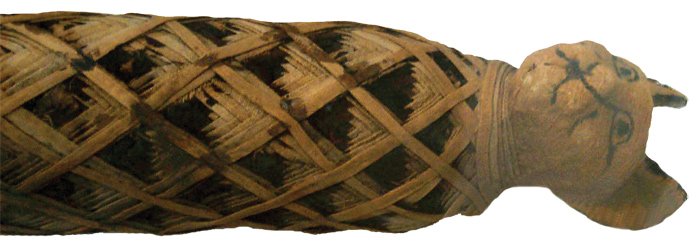
Cats were regarded as sacred and thousands of cats were mummified. The cat god was called Bubast.
More recently, in 2001, American excavations at Abydos, led by Dr. David O’Connor of the Institute of Fine Arts at New York University, revealed the first of a possible 14 wooden boats dating to the 1st Dynasty of Egypt. The boats were buried, not in pits like the more famous boats of Giza, but in mud brick buildings more than six miles (ten km) from the Nile. They had been overlooked by archaeologists for so long because, being close to the tomb of Khasekhemwy (the last ruler of the 2nd Dynasty who used monumental stone), the crumbling mud brick ruins were not considered likely to house anything of significance.
These boats are about 75 feet (23 m) long and up to 10 feet (3 m) wide. When new each ship could have held each 30 rowers in addition to the passengers. Unlike the Giza ships, which were dismantled and stored as a parcel of planks and rope, the Abydos boats were buried complete and intact. All this has fueled fresh speculation that perhaps these early dynasty kings were really buried at Abydos.
In these early dynasties, the bodies were very poorly preserved, and not much more than the skeletons of the dead survived. The best-preserved bodies were actually those of the poor people who were simply buried in the hot dry sand which dehydrated the body and fairly well preserved it. The rich people, however, were buried in baskets, reed coffins, or sarcophagi (stone coffins), and their flesh decayed away. The art of embalming was developed later, and by the 18th Dynasty the bodies were well preserved and had quite a life-like appearance.
There were different methods practiced by the embalmers, but in many cases a hole was drilled through a nostril into the skull, and the brain was scooped out and discarded. A slit was made in the abdomen and the internal organs were removed. The stomach, lungs, intestines, and liver were then interred in canopic jars and buried separately from the body. The body was then immersed in natron powder. This was a salty mineral which was found in the Natrun Valley north of Cairo, hence its name “natron.” This absorbed the fluids in the body and virtually pickled it. The body remained there for 40 days, after which the natron was removed and the body wrapped in lengths of linen bandages. These in turn were smothered in resin, beeswax, and in some cases, with bitumen. The Persian word for bitumen was mummiya, from which our English word “mummy” is derived.
In the case of the royal burials, costly ornaments were wrapped among the bandages, which explains why tomb robbers stole not only the valuables in the tombs, but the bodies themselves. No complete body of a king has ever been found in a pyramid.
The whole process of embalming took many days and is described by the Greek traveler Herodotus, who visited Egypt in the fifth century B.C. In his book The Histories, which is still available from bookshops today, he wrote,
As much as possible of the brain is extracted through the nostrils with an iron hook, and what the hook cannot reach is rinsed out with drugs. Next, the flank is laid open with a flint knife and the whole contents of the abdomen removed. The cavity is then thoroughly cleansed and washed out, first with palm wine and again with an infusion of pounded spices. After that it is filled with pure bruised myrrh, cassia, and every other aromatic substance with the exception of frankincense, and sewn up again, after which the body is placed in natron, covered over entirely for 70 days—never longer. When this period, which must not be exceeded, is over, the body is washed and then wrapped from head to foot in linen cut into strips and smeared with gum, which is commonly used by the Egyptians instead of glue.1
The Hebrew Bible also refers to this practice when it records the death of Jacob in Egypt. “And Joseph commanded his servants the physicians to embalm his father. So the physicians embalmed Israel. Forty days were required for him, for such are the days required for those who are embalmed; and the Egyptians mourned for him seventy days” (Gen. 50:2-3).
In November 1993, Bob Brier, who is chairman of the Philosophy Department at C.W. Post College of Long Island University, New York, was struck with a bright idea. He would embalm a body exactly as the ancient Egyptians used to do it. In January 1994, Brier traveled to Egypt to purchase and ship back to the United States 50 pounds of natron from the Wadi Natrun quarries, the same place from which ancient embalmers procured their natron. From spice bazaars in the back streets of Cairo he purchased frankincense and myrrh. A friend, who was an expert in metallurgy, cast bronze knives for removing the internal organs. These knives were made from 88 percent copper and 12 percent tin, the same alloy that was used during the 18th Dynasty. Brier even went the second mile and procured an obsidian (stone) knife with which to make the initial incision, equivalent to the “sharp Ethiopian stone” mentioned by Herodotus. He tried to plan every detail as it would have been thousands of years ago.
He subsequently wrote a 320-page book called Egyptian Mummies.2 In a brief paragraph at the end of the book, Brier records that the modern embalming took place privately in November 1994, with only National Geographic writers and photographers present. He found that the record that Herodotus left seemed to be quite workable except that he could not scoop out the brain with the iron hook. He had to decimate the brain with the iron instrument and then wash the contents out with water.
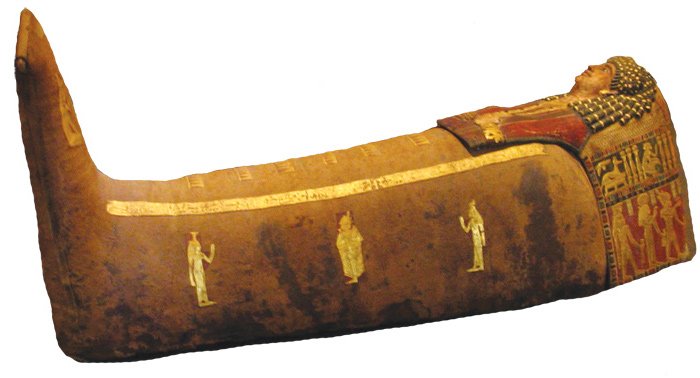
In later periods wooden coffins were very ornate and frequently gilded with beautiful representations of the dead.
The Egyptians not only embalmed their dead relatives, but they also embalmed animals and birds. Monkeys, cats, and ibises were especially reverenced, and virtually thousands of these have been found.
Unfortunately, most of the human mummies have been destroyed. In the early days of exploration and travel in Egypt, mummies were plentiful and were shipped back to Europe in boatloads. They were popularly used in medicines, and thousands were used as fertilizers. When Mark Twain visited Egypt, he claimed that they were even used as firewood in steam trains. The resins and bitumen used in the mummification burned fiercely.
Over the past 200 years, the archaeological discoveries in Egypt have fascinated both scholars and the general public alike. One of the reasons for this is that the remains of Egyptian civilization provide a tangible link with our past—a link which goes back to within a couple of generations of Noah’s Flood. The fact that the very first kings of Egypt had their boats preserved in death may constitute further evidence that they were well aware of the Flood that had wiped out most of mankind just a couple of centuries earlier and were taking precautions. The elaborate tombs that they built and the mummies they left behind remind us that they were highly intelligent people, just like us, living thousands of years ago in a civilization that suddenly appeared. A similar picture of the past is described in the ancient records of the Bible, which were preserved by the Israelites who lived in the same region of the world. In the chapters which follow, we will explore more discoveries that provide clues linking the tangible records in Egypt with the written record of the Bible to form a complete tapestry of the chronology of our past.
Unwrapping the Pharaohs
Adults and children alike are fascinated by Egyptian civilization. But most modern archaeologists have lately tried to use Egyptian chronology to dispute the biblical record. Secular textbooks and videos challenge the faith of students and discredit the biblical account of Exodus. Those who wish to defend the accuracy of the Bible now have an incredible tool in this exciting book that provides compelling confirmation of the biblical account.
Read Online Buy BookFootnotes
- Herodotus, The Histories, translated by Audrey de Selincourt (Harmondsworth, Middlesex, England: Penguin Books, 1976), p. 160.
- Bob Brier, Egyptian Mummies: Unravelling the Secret of an Ancient Art (New York: William Morrow and Company Inc. 1994), p. 323-324.
Recommended Resources

Answers in Genesis is an apologetics ministry, dedicated to helping Christians defend their faith and proclaim the good news of Jesus Christ.
- Customer Service 800.778.3390
- © 2024 Answers in Genesis


